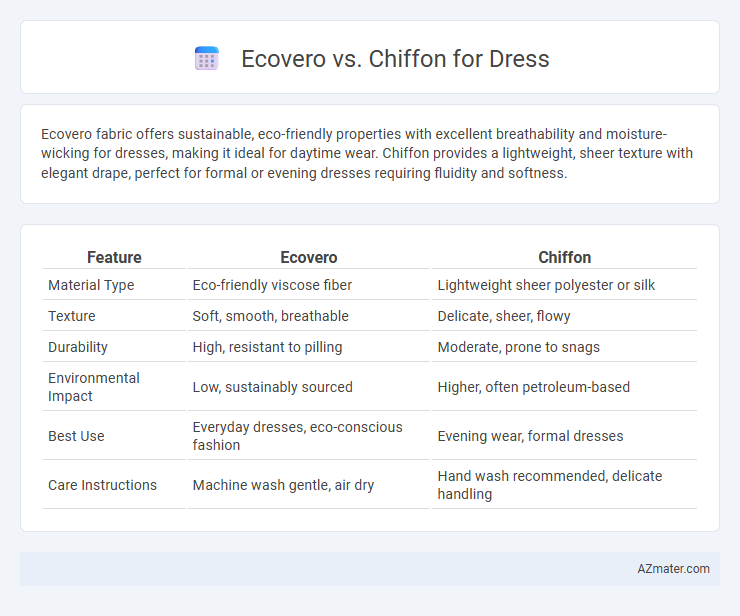Ecovero fabric offers sustainable, eco-friendly properties with excellent breathability and moisture-wicking for dresses, making it ideal for daytime wear. Chiffon provides a lightweight, sheer texture with elegant drape, perfect for formal or evening dresses requiring fluidity and softness.
Table of Comparison
| Feature | Ecovero | Chiffon |
|---|---|---|
| Material Type | Eco-friendly viscose fiber | Lightweight sheer polyester or silk |
| Texture | Soft, smooth, breathable | Delicate, sheer, flowy |
| Durability | High, resistant to pilling | Moderate, prone to snags |
| Environmental Impact | Low, sustainably sourced | Higher, often petroleum-based |
| Best Use | Everyday dresses, eco-conscious fashion | Evening wear, formal dresses |
| Care Instructions | Machine wash gentle, air dry | Hand wash recommended, delicate handling |
Introduction to Ecovero and Chiffon Fabrics
Ecovero is an eco-friendly, sustainable fabric made from certified renewable wood sources, known for its soft texture and reduced environmental impact compared to traditional viscose. Chiffon is a lightweight, sheer fabric typically made from silk, nylon, or polyester, prized for its delicate drape and airy feel in dressmaking. Both fabrics offer distinct qualities: Ecovero provides sustainability and breathability, while chiffon excels in elegance and lightness.
Fabric Composition and Origin
Ecovero fabric is made from sustainably sourced viscose derived from certified wood pulp, emphasizing eco-friendly production primarily in Europe. Chiffon is a lightweight, sheer fabric that can be composed of silk, polyester, or nylon, often produced in regions known for textile manufacturing like China and India. The key contrast lies in Ecovero's eco-certified viscose origin versus Chiffon's varied synthetic or natural fiber composition, impacting breathability and environmental footprint.
Environmental Impact and Sustainability
Ecovero fabric is made from certified sustainable wood pulp and uses a closed-loop production process that minimizes water and energy consumption, significantly reducing its environmental footprint compared to conventional viscose. Chiffon, often made from synthetic fibers like polyester derived from petroleum, has a higher carbon footprint, slower biodegradability, and contributes to microplastic pollution. Choosing Ecovero for dresses supports eco-friendly manufacturing practices and promotes sustainable fashion by reducing reliance on fossil fuels and lowering greenhouse gas emissions.
Texture and Feel: Ecovero vs Chiffon
Ecovero fabric offers a smooth, soft texture with a natural matte finish, providing breathability and eco-friendly comfort ideal for dresses. Chiffon features a lightweight, sheer texture with a slightly crisp feel, lending an elegant, flowy drape to garments. The difference in texture means Ecovero suits structured, comfortable wear while chiffon excels in airy, delicate dress designs.
Breathability and Comfort for Dresses
Ecovero fabric offers superior breathability due to its sustainable viscose fibers derived from renewable wood sources, which allow for excellent moisture-wicking and airflow in dresses. Chiffon, while lightweight and airy, is typically made from synthetic fibers or silk, providing a slightly less breathable but smooth and flowing comfort ideal for formal or layered dresses. Choosing Ecovero enhances comfort in warm weather with its natural ventilation, whereas chiffon excels in elegance and softness but may retain heat more in comparison.
Durability and Maintenance Requirements
Ecovero fabric offers superior durability compared to chiffon, as it is made from certified sustainable viscose that resists wear and tear, making it ideal for frequent use. Chiffon, being a lightweight and delicate fabric, requires gentle handling and specialized cleaning methods to avoid damage, resulting in higher maintenance needs. Choosing Ecovero ensures a longer-lasting dress with easier care, while chiffon demands more attention to preserve its delicate texture and appearance.
Color Retention and Dyeing Properties
Ecovero fibers exhibit superior color retention due to their eco-friendly viscose production process, which allows dyes to penetrate evenly and maintain vibrancy over time. Chiffon, often made from silk or polyester, offers delicate translucency but can show fading more quickly as its dyeing process is less stable and more prone to color loss with washing. For dresses requiring long-lasting, rich colors and sustainable materials, Ecovero provides a more reliable dyeing performance compared to traditional chiffon fabrics.
Style Versatility: Formal and Casual Dress Options
Ecovero fabric offers sustainable style versatility, blending eco-friendly viscose fibers with a smooth finish suitable for both formal and casual dresses. Chiffon, lightweight and sheer, excels in creating elegant, flowy formal dresses while also adaptable for casual wear when layered or paired with relaxed silhouettes. Both materials support diverse dress options, with Ecovero emphasizing eco-conscious fashion and chiffon prioritizing delicate, airy aesthetics.
Price Comparison and Market Availability
Ecovero fabrics offer a sustainable alternative to traditional chiffon, typically priced higher due to eco-friendly production methods and certifications like OEKO-TEX. Chiffon remains widely available across global markets, with a diverse price range depending on fiber content and brand, making it more accessible for budget-conscious consumers. While Ecovero is gaining traction in niche sustainable fashion sectors, chiffon continues to dominate mass-market dress materials due to its affordability and extensive availability.
Choosing the Best Fabric for Your Dress: Ecovero or Chiffon
Ecovero fabric, made from sustainably sourced wood pulp, offers breathability, moisture-wicking properties, and eco-friendliness, making it ideal for environmentally conscious dressmakers. Chiffon, known for its lightweight, sheer texture and elegant drape, excels in creating delicate, flowing dresses suitable for formal occasions. Selecting between Ecovero and chiffon depends on whether you prioritize sustainability and comfort or a classic, airy aesthetic for your dress design.

Infographic: Ecovero vs Chiffon for Dress
 azmater.com
azmater.com